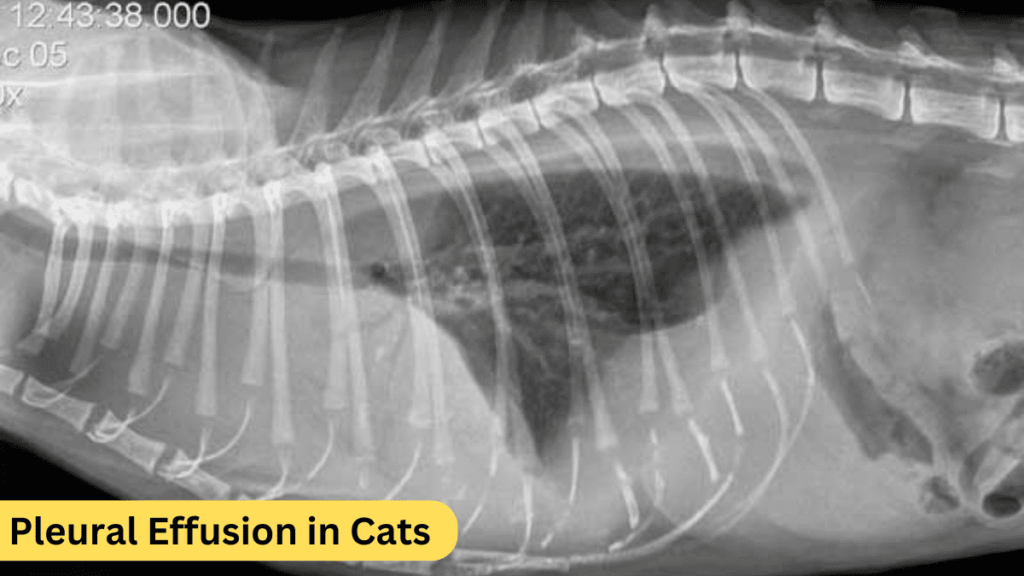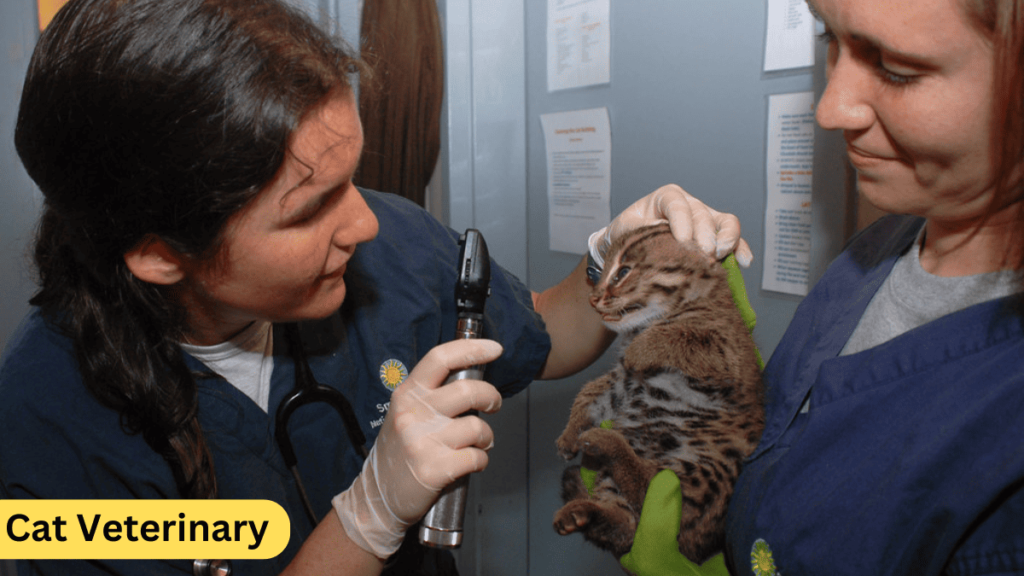Pleural effusion in cats is a serious medical condition that occurs when fluid builds up between the pleura, the thin layers lining the chest cavity and covering the lungs. This fluid accumulation prevents the lungs from expanding fully, causing difficulty in breathing. If not addressed promptly, pleural effusion can be life-threatening. This comprehensive guide will delve into Pleural Effusion in Cats Treatment 2024. We will also answer common questions and provide key insights to ensure your cat gets the best care possible.

Table of Contents
What is Pleural Effusion in Cats?

Pleural effusion refers to the accumulation of excess fluid in the pleural space, which surrounds the lungs but is outside the lung tissue itself. This fluid can come from blood, lymphatic fluid, pus, or other bodily fluids depending on the underlying cause. This makes it difficult for the lungs to expand properly, leading to breathing difficulties.
Pleural effusion differs from pulmonary edema, where fluid accumulates inside the lungs rather than around them. Both conditions can impair a cat’s breathing but require different treatment approaches.
What Causes Pleural Effusion in Cats?
Several factors can lead to pleural effusion in cats. Understanding the cause is critical for selecting the most effective treatment. The following are the most common causes:
- Congestive Heart Failure (CHF): The leading cause of pleural effusion in cats. When the heart fails to pump efficiently, fluid can accumulate in the pleural cavity.
- Cancer: Tumors, especially in the chest cavity (such as lymphoma), can lead to pleural effusion as the tumor obstructs normal fluid flow or secretes fluid itself.
- Pyothorax: Bacterial infections can lead to pus accumulating in the pleural space, a condition known as pyothorax.
- Chylothorax: This occurs when lymphatic fluid leaks into the pleural space due to damage to the lymphatic system, which may be caused by trauma, heart disease, or an unknown reason (idiopathic chylothorax).
- Feline Infectious Peritonitis (FIP): Caused by a mutated coronavirus, this condition leads to fluid buildup in the chest or abdominal cavity.
- Trauma: Injury to the chest, such as being hit by a car or falling from a height, can cause bleeding or fluid accumulation in the pleural cavity.
- Lung Lobe Torsion: This rare condition involves the twisting of a lung lobe, cutting off blood supply and causing pleural effusion.
- Diaphragmatic Hernia: A tear in the diaphragm that allows abdominal organs to enter the chest cavity, causing pleural effusion.
Symptoms of Pleural Effusion in Cats
Pleural effusion prevents the lungs from fully expanding, which can lead to the following clinical signs:
- Rapid, shallow breathing
- Difficulty breathing (dyspnea)
- Open-mouth breathing
- Cyanosis (blue-tinged gums due to lack of oxygen)
- Lethargy
- Loss of appetite
- Weight loss
- Coughing (in some cases)
- Enlarged abdomen (in cases of chylothorax)
- Labored breathing with significant abdominal effort
How is Pleural Effusion Diagnosed?
Diagnosis is crucial for effective treatment. A veterinarian will typically use the following diagnostic tools:
- Physical Examination: Observing labored breathing, blue gums, and muffled lung sounds.
- Chest Radiographs (X-rays): X-rays are essential for visualizing the fluid around the lungs.
- Ultrasound: This may help to confirm the presence of fluid and pinpoint the cause.
- Thoracocentesis: A procedure where a needle is used to extract fluid from the pleural space, which is then analyzed to determine its nature (e.g., pus, blood, lymph).
- Blood Tests: To check for infections, heart failure, or underlying diseases like FIP.
Treatment for Pleural Effusion in Cats

1. Emergency Treatment
If a cat is in respiratory distress due to pleural effusion, immediate action is needed to stabilize the condition:
- Oxygen Therapy: This provides additional oxygen to cats struggling to breathe.
- Thoracocentesis: The veterinarian will insert a sterile needle or catheter into the pleural cavity to remove the excess fluid. This relieves pressure on the lungs, allowing the cat to breathe more easily. It can also provide valuable diagnostic information from the fluid sample.
2. Long-Term Treatment
Once the cat is stabilized, the focus shifts to treating the underlying cause of the pleural effusion:
- Congestive Heart Failure (CHF): Medications like diuretics (e.g., furosemide) are used to remove excess fluid from the body. Other heart medications, such as ACE inhibitors or beta-blockers, may also be prescribed to improve heart function.
- Cancer: Treatment options may include surgery, chemotherapy, radiation therapy, or palliative care, depending on the type and stage of the cancer.
- Pyothorax (Bacterial Infection): Antibiotics are the main treatment for bacterial infections. In severe cases, surgical intervention or repeated fluid drainage may be necessary.
- Chylothorax: Treatment may involve a low-fat diet, medication to reduce chyle production, or surgery to tie off the damaged lymphatic duct.
- Feline Infectious Peritonitis (FIP): Treatment for FIP is often supportive, focusing on improving the cat’s quality of life. Recent advancements in antiviral drugs may provide hope in some cases.
- Trauma: Treatment depends on the severity of the injury but may include pain management, fluid drainage, and surgery in cases of severe trauma or diaphragmatic hernia.
3. Repeat Thoracocentesis or Chest Tube Placement
For cats with chronic pleural effusion, especially those with chylothorax or heart failure, repeated fluid drainage may be necessary. In some cases, a chest tube may be inserted for ongoing fluid removal.
Read More:
Cats with Colds Home Treatments: A 2024 Guide
Bacterial Pleural Effusion in Cats Treatment
When pleural effusion is caused by a bacterial infection (pyothorax), the treatment plan typically involves:
- Antibiotics: A course of broad-spectrum antibiotics is initiated, often based on the bacteria identified in the fluid culture.
- Thoracostomy Tube: For severe infections, a chest tube may be placed to continuously drain pus from the pleural cavity.
- Supportive Care: This may include fluids, pain management, and oxygen therapy as needed.
Prognosis of Pleural Effusion in Cats
The prognosis for cats with pleural effusion depends on the underlying cause:
- Heart Failure: With appropriate treatment, many cats with CHF can live a relatively normal life.
- Cancer: The prognosis depends on the type, location, and stage of the cancer.
- Pyothorax: With aggressive antibiotic treatment, many cats can recover from a bacterial infection, but the condition can be life-threatening if left untreated.
- Chylothorax: The prognosis varies, and some cats may require lifelong management, while others may recover fully with surgery.
- FIP: This is a severe condition with a poor prognosis, but newer treatments show some promise.
Common Causes, Symptoms, and Treatments for Pleural Effusion in Cats
| Cause | Symptoms | Treatment |
|---|---|---|
| Congestive Heart Failure | Rapid breathing, lethargy | Diuretics, ACE inhibitors, heart medications |
| Cancer | Difficulty breathing, weight loss | Chemotherapy, surgery, radiation, palliative care |
| Pyothorax (Bacterial Infection) | Coughing, fever, lethargy | Antibiotics, fluid drainage, chest tube |
| Chylothorax | Enlarged abdomen, shallow breathing | Low-fat diet, surgery, medication |
| Feline Infectious Peritonitis | Weight loss, lethargy, abdominal swelling | Supportive care, antiviral therapy (if available) |
| Trauma | Blue gums, labored breathing | Pain management, surgery, thoracocentesis |
Frequently Asked Questions (FAQs) Pleural Effusion in Cats Treatment
Q1. What is the best treatment for pleural effusion in cats?
The best treatment for pleural effusion depends on its cause. For heart failure, diuretics and heart medications are often used. For bacterial infections, antibiotics and fluid drainage are necessary. Surgery may be needed in cases of trauma, chylothorax, or cancer.
Q2. Can pleural effusion in cats be cured?
The cure depends on the underlying cause. Some conditions, such as bacterial infections, can be fully treated, while others, like heart failure or cancer, may require long-term management.
Q3. How long can a cat live with pleural effusion?
With proper treatment, cats with manageable conditions like heart failure or infections can live for several years. However, conditions like cancer or FIP often have poorer prognoses.
Conclusion
Pleural effusion in cats is a serious condition, but with prompt diagnosis and appropriate treatment, many cats can recover or manage the symptoms effectively. If your cat is showing signs of difficulty breathing, don’t hesitate to seek veterinary care. Understanding the underlying cause is key to developing a successful treatment plan, whether it involves medication, surgery, or long-term management. Stay informed, and ensure your cat receives the best possible care in 2024 and beyond.
